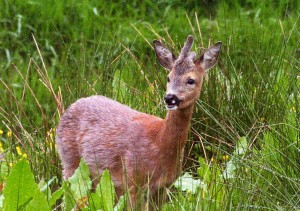 It is all too easy at this time of the year to become an “Armchair naturalist” as there are various ways of connecting with a very wide range of wildlife. Television, web sites, books, magazine are all there for the asking. Another way of contact is the ever increasingly popular pastime of feeding birds in the garden or, in some cases, even animals. The various feeders will attract a variety of birds and there is always the chance at this time of the year for the more unusual ones such as brambling moving from Scandinavia to spend the winter with us. Then there is the even more unusual visitor such as the jay. What can be more satisfying that watching such birds at close quarters? The interesting point about this is that anyone who puts out even two or three feeders can participate in this pastime.
It is all too easy at this time of the year to become an “Armchair naturalist” as there are various ways of connecting with a very wide range of wildlife. Television, web sites, books, magazine are all there for the asking. Another way of contact is the ever increasingly popular pastime of feeding birds in the garden or, in some cases, even animals. The various feeders will attract a variety of birds and there is always the chance at this time of the year for the more unusual ones such as brambling moving from Scandinavia to spend the winter with us. Then there is the even more unusual visitor such as the jay. What can be more satisfying that watching such birds at close quarters? The interesting point about this is that anyone who puts out even two or three feeders can participate in this pastime.
However, the best approach is to forget all these armchair comforts and get out into the field which is where the real contact with wildlife begins. Winter weather means you have to be more selective than usual about the various sites to visit. There is a wide choice with many people going to the coast to see the spectacular numbers of wintering birds, many boosted by enormous numbers from the continent or the north. Inland the choice may be limited especially when the colder weather intensifies. One place that is always reliable for a wide range of wildlife is woodland and there is no shortage around Inverness and beyond. One favourite place for naturalists is the extensive areas of old Caledonian pine forest and you are spoilt for choice.
One of my favourite places is the Glen Affric woodland that has now been declared a National Nature Reserve and deservedly so with its long history of management for wildlife by the Forestry Commission. In such areas of woodland it is as if time has stood still as parts of it cannot be very much different than it was centuries ago when the wolf haunted the area as did wild boar and beaver. There is one secret about watching wildlife in such areas and that is to try and blend in with the woodland. Bearing in mind the need to keep warm, with adequate clothing, then choose somewhere just to sit or stand and keep quiet and still for as long as you can. When you first stop there may be virtually nothing to see or, even more important in such areas, to hear. Slowly the birds will resume their activities and there is always the chance of seeing some of the rarer woodland birds. These include the crossbill and the crested tit. There is one giveaway with the crossbills as, if you lucky, under the Scots pine you may be lucky enough to find fir cones that have been opened up by the crossed beaks. These beaks are designed to extract one of their favourite food sources, the seeds within the Scots pine cones. Interestingly, when the crossbills first leave the nest their beaks may be crossed in either direction. The other intriguing fact about the wildlife of Glen Affric is that there is a good chance of seeing all the three commoner species of deer in the Highlands. The red and roe deer are native whilst the third, the sika, is introduced.
